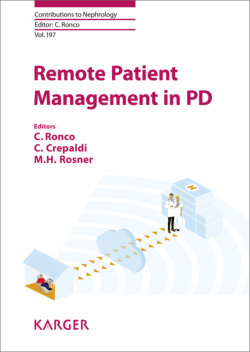Читать книгу Remote Patient Management in Peritoneal Dialysis - Группа авторов - Страница 25
На сайте Литреса книга снята с продажи.
HOMECHOICE CLARIA/SHARESOURCE Revolution
ОглавлениеA true revolution of PD occurred with the advent of real-time bidirectional communication between the cycler at patient’s home and the hospital care team. This is today offered by the new HOMECHOICE CLARIA equipped with the cloud-based SHARESOURCE platform (Baxter, Dirfield, IL, USA). Physicians and nurses can verify and change the dialysis prescription by a simple login to the SHARESOURCE platform, while patients can stay out-of-hospital avoiding long and time-consuming travels to the PD center. There is no need to bring data cards for the periodic scheduled consultation since data are constantly supervised by the care team.
While patients can safely and comfortably continue their treatment at home, the hospital team supervises daily the performance of the cycler and the adherence to prescription, identifying any possible problem in real time. The possibility to see at-a-glance a series of parameters allows the care team to correct problems and verify the correspondence between prescribed and effectively delivered treatment doses. Information about treatment can also be analyzed and visualized as graphs and statistical trends for a period of interest. At the same time, change in prescription can be done remotely via computer and the patient only needs to accept and confirm the variation when he/she switches on the machine in his/her own home. The bidirectional communication helps to troubleshoot problems. Patients do not need to come to the hospital when a problem occurs with the machine, and the hospital team can rapidly correct and immediately verify the effect of a variation in prescription. All these aspects related to the HOMECHOICE CLARIA with Sharesource make a real revolution in PD allowing a true RPM [10–13].
RPM in PD is one important possibility in the area of telemedicine, improving the quality of the therapy and possibly expanding its application even in patients with lack of confidence or limited manual skills. RPM allows to reduce patient access to the center, affecting healthcare and personal cost. It may also reduce technique failure and patient drop out, increasing patient self-confidence with the home-based therapy. Finally interventions on dialysis schedules based on continuous treatment surveillance allow for a true personalization of therapy, in agreement with the most recent criteria of precision medicine [12, 13].
